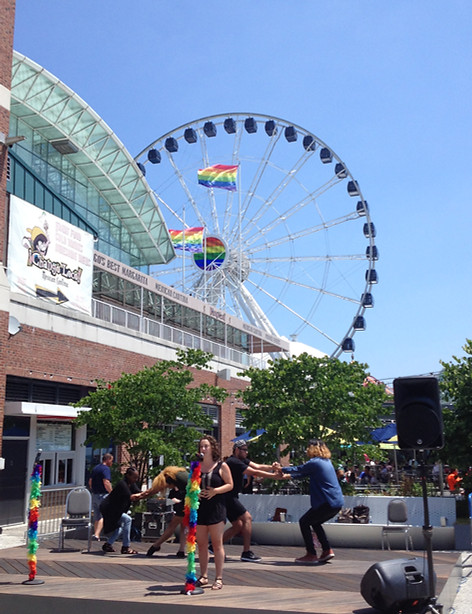
CASE STUDY
Reshaping the Cultural Identity of a Landmark Public Space
Evaluation of the Arts & Discovery Program at Chicago’s Navy Pier
The Client
Navy Pier is one of the most popular and historic landmarks in the city of Chicago. Extending six city blocks into Lake Michigan, the 100-year old attraction has positioned itself to serve as a model for urban community gathering spaces in the 21st century with a massive entertainment, conference, and recreational complex that draws in nearly nine million people per year. With the additional release in 2011 of a new ‘Centennial’ vision and development plan, the Pier’s leadership set in motion a number of enhancements to its physical infrastructure and overall direction as a major city institution.
The Challenge
In pursuit of realizing the new centennial vision, Navy Pier undertook a series of redevelopment efforts in 2016 under the direction of Navy Pier, Inc., the site’s governing body, to transform itself into a 21st century public space that better connected with Chicago’s rich patchwork of diverse communities and audiences — many of which have perceived the Pier in the past as mainly a ‘tourist destination’.
Committing to a fresh approach, Navy Pier created an Arts & Discovery pilot program suite composed of several new artistic, cultural, educational, and entertainment offerings designed to attract both long-time locals and out-of-towners searching for an eclectic and authentic Chicago experience. Although promising in concept, the new programs required testing and the evaluation of their effectiveness at achieving the goals set by the centennial vision.
Service Types
Program Evaluation and Cultural Plan Development
The Task
As part of a more comprehensive consulting and research project overseen by Dickerson Global Advisors, NCAP was hired to evaluate a selection of the Arts & Discovery pilot programs, examining their execution and impact in relation to the goals established by Navy Pier’s centennial vision. NCAP evaluated three programs that took place on the Pier from June to August 2016:
Family Pride: All-day event celebrating LGBTQ families and the community
Pier Dance: Weekly event featuring performances by local bands to encourage social interaction through music and dance
Beatbox: Urban art form showcase for local beatbox performers and graffiti artists

People surrounding the main stage of the Beatbox event.
Our Approach
The evaluation involved a thorough analysis of guest responses to both the pilot programs and key aspects of the general Navy Pier experience. We complemented this effort by undertaking an additional assessment of the program execution and partnership model required for planning and facilitating the Arts & Discovery initiative.
In an attempt to help initially frame the evaluation process, our team completed preliminary market landscape research addressing a number of relevant topics, including cultural scenes, creative placemaking, and trends in large-scale venue arts programming.
To gather guest feedback, NCAP surveyed and interviewed program guests concerning five areas of interest: (1) perception of Navy Pier, (2) engaged activities during visit, (3) quality of program experience, (4) educational opportunities, and (5) impact of program. Supplementing the guest data, ethnographic event observations were consistently recorded and analyzed to assist in identifying key programmatic ideas and recurring themes.
Our research team also used surveys and in-depth interviews to collect feedback from Navy Pier staff and leadership, as well as from the artists and organizations that partnered with Navy Pier to execute the program events. The surveys and interviews addressed five areas: (1) meaning of partnership, (2) program planning, (3) event execution, (4) program success, and (5) quality of partnership.
Throughout the entire evaluation process, NCAP employed a combination of qualitative and quantitative methods and tools to provide a thorough explanatory assessment of the pilot programs.

Performers at the Family Pride Event.

Findings
Over the course of the 10-week pilot program evaluation, NCAP identified five main takeaways:
-
Guests were receptive to diverse programming and audiences in an enhanced pier setting;
-
Program development and execution would prove even more effective if afforded concentrated planning time and dedicated onsite staff support;
-
Institutional exposure and program innovation were improved through wide-ranging partnerships with local artists and organizations;
-
Matching target audiences with specific programming contributed to positive event outcomes; and
-
The implemented experimental approach employed for pilot programs is not only useful but also should be further explored and incorporated into a long-term strategy when budget and resources allow.
Crowds gathering to take part in Pier Dance.
Summary
-
Drawing on a variety of NCAP’s collective tools and skills, the project required the use of both sophisticated quantitative and qualitative research methods - including extensive field research, scientific surveys, and in-depth interviews.
-
Working with fellow consultants as part of a larger research project under the direction of Dickerson Global Advisors enabled our team to contribute both original and complementary evaluation work and key takeaways that substantively aided a popular cultural gathering center essential to a major metropolitan area.
-
Through due process and diligent data collection, the execution of our program evaluation service yielded insights and tailored cultural planning recommendations delivered to Navy Pier for their strategy development consideration going forward in the future.

View of Chicago skyline from Navy Pier following Family Pride.
